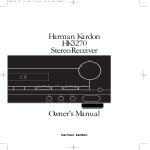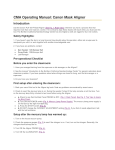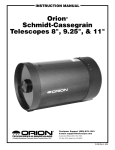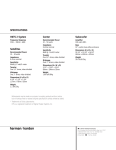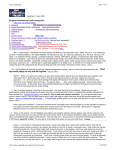Download Steering and Suspension
Transcript
STEERING& SUSPENSION WHERE IS THE WEAR? BY KARL SEYFERT I t’s no longer considered rare or unusual for a vehicle to travel 100,000 miles or more and still have all of its original steering and suspension components. This extended wear trend includes other areas of the vehicle as well. Engines last longer; transmissions last longer; everything lasts longer. Better cars? Better roads? Better maintenance? We may disagree on why this is true, but at least we can probably agree that it is true. None of these parts is the same after 100,000 miles as it was at 0 miles, of course. In the case of steering and suspension parts, the deterioration is gradual, and it may be difficult for the driver to notice anything has changed until things have gotten bad enough to represent a safety hazard. Rather than waiting until then, it’s best to take a proactive approach. 34 June 2005 Why wait until the vehicle comes in behind a tow truck to start thinking about steering and suspension wear? Road Test Begin with a road test. If the customer is available, take him along or have him drive to get a feel for the vehicle. Use your eyes, ears and the seat of your pants as you drive. Do you hear any unusual noises? Does the vehicle seem to bob and weave as it passes over irregularities in the pavement? Does it feel like anything unusual is going on under the vehicle? As steering parts wear, they cause the steering to become vague and unresponsive. When suspension parts like ball joints and control arm bushings wear, they cause unfamiliar clunks and bumps as well as uneven tire wear. Loose or worn steering or suspension components can also cause a Photo: Karl Seyfert Regardless of the materials used, friction and gravity inevitably cause wear that degrades steering and suspension performance on all vehicles—even those constructed of unobtanium. pull that occurs abruptly when the vehicle hits a bump. A steering wheel that changes positions during straightahead driving after braking is a tip-off that something is loose in the suspension or steering, causing a sudden toe change. Many techs still attempt to check the shocks and struts using the timehonored bounce test. Each end of the vehicle is manually bounced up and down, then released. The theory is that a worn shock or strut will allow too many oscillations before the bouncing stops. What’s never been established is how hard the suspension should be bounced, how many oscillations are too many and how many are just enough. You can use the vehicle’s weight (instead of your own) to conduct a shock absorber test during your road test. First, drive up a gentle grade at 25 to 35 mph. Uneven pavement is actually an advantage here. Watch the rearview mirror as you drive. If the rear end of the vehicle seems to float or bobble over the bumps, that’s a tipoff that the rear shocks need attention. Next, select a street and time when there are no cars immediately behind you. To test both the front and rear shocks, brake hard from a speed of 25 to 35 mph, but not hard enough to lock the wheels. Hold firm pressure on the pedal all the way through to a complete stop. If you don’t feel a jolt at the end of the maneuver, repeat the test, and don’t ease off the brakes until you feel it. Driving repeatedly over a bumpy stretch of road is also a good way to check for shock absorber fade resistance. The same inertial weight transfer that jerks your head at the end of those hard stops will also compress the springs sufficiently to reveal a weak shock. The nose of the vehicle should sink, rise and center while the tail should mirror its motions. Any further bobbing motions indicate a weak shock. If either the front or rear fails to center effectively, one of the June 2005 35 STEERING & SUSPENSION: WHERE IS THE WEAR? shocks may be sticking. Similarly, if the vehicle bobs its front or rear more than once, the shocks need replacing. Visual Inspection While misaligned wheels will often cause a constant pull, braking can aggravate a slight pull. An uneven scrub radius can cause a severe pull under braking. A zero scrub radius will have little effect on steering pull if one front brake works harder than the other. A positive scrub radius will pull very hard, while a negative scrub radius will have a minimal effect. Most front-drive vehicles have a zero or negative scrub radius to counteract the effects of torque steer. If the scrub radii of both front wheels are near equal, they’ll cancel each other out. Problems will occur if there’s a difference between the two. This can happen with bent front suspension components, wheels with different offsets or missing spacers on an aftermarket wheel. Photo courtesy General Motors After the road test, get the vehicle on a lift and conduct a thorough steering and suspension inspection. If you suspect a steering- or suspension-related pull, check the components as you would during a prealignment inspection. Be on the lookout for loose parts and any indication of moving components such as loose control arm bolts. Clean areas or scraped paint around bolts and nuts can indicate that something that isn’t supposed to is moving around. Anything that allows the wheels to point where they’re not supposed to while braking can cause a pull. Loose components can also produce a single-clunk noise when the brakes are applied and the vehicle weight shifts. Photo courtesy University of Toyota, Toyota Motor Sales, USA Which joint is the load-bearing joint? This multilink Cadillac front suspension makes sure the tires remain perpendicular to the road, regardless of load or road. Proper testing methods are required to identify worn components. At the other end of the price spectrum, this Toyota Echo uses a simple McPherson strut front suspension. The single lower control arm and ball joint locate the suspension at the bottom. Is it a load-bearing joint? 36 June 2005 Shocks When they aren’t being ignored, shock absorbers are often replaced in an attempt to correct a condition that doesn’t need correcting. A light film of oil on the upper portion of the shock absorber tube or body is acceptable. However, a shock absorber dripping fluid is a sign of leakage, and the unit should be replaced. Just make sure the leak is not coming from another part. Shock absorbers do not support suspension loads. Don’t replace shocks to correct vehicle sag; that’s a job for the springs. The basic function of the shock absorber is to serve as a damping device for the spring or torsion bar suspension. Shocks keep the wheels in contact with the road surface under all road and load conditions. They also keep the springs from oscillating freely after the wheels roll over road irregularities. Damping forces should be equal on each side of the vehicle. Some vehicles are equipped with gas-charged shocks. Their sealed gas pressure resists expansion and compression. Some common indications of shock absorber failure are steering or handling difficulty, uneven braking, abnormal tire wear (especially cupping), springs bottoming out, excessive bouncing after stops, worn steering and suspension components and noise caused by loose shock absorber attaching parts. A worn strut mount (the red area in the illustration) can produce noise, as well as steering pull and memory steer problems. Strut mounts should be carefully inspected and replaced, if necessary, during spring or strut service. This Ford Fusion front suspension combines a strut with upper and lower control arms and a pair of ball joints. The bottom of the strut is attached to the lower control arm, not the knuckle. Unlike a conventional McPherson strut suspension, it has no suspension locating duties. axle and remove the shock’s lower attachment. Grasp the shock absorber body and stroke it up and down as far as possible. To bench-test a shock absorber, position it in the same direction it’s installed in the vehicle, then extend it fully. Next, turn it upside down and fully compress it. Repeat several times. Replace the shock absorber if there’s a lag or skip near the midstroke as the shaft changes direction, the shaft seizes at any point in its travel (except at the ends), any noise other than a swish or click is heard when the stroke is reversed rapidly, any leaks are observed or the action remains erratic after purging air. Photo courtesy Ford Motor Co. The shock absorber action should be smooth and uniform throughout each stroke. To check the shock on the vehicle, support the lower control arm or Illustration courtesy Ford Motor Co. Illustration courtesy University of Toyota, Toyota Motor Sales, USA STEERING & SUSPENSION: WHERE IS THE WEAR? Many late-model vehicles have multilink independent rear suspensions. These designs provide superior road-holding along with a comfortable ride. The multitude of bushings and joints can make a noise or handling diagnosis a challenge, however. 38 June 2005 Struts & Springs The strut shaft is a structural suspension member that takes the place of the upper control arm bushings and upper ball joint. The strut shaft is also the shock absorber shaft, so it must be able to handle both vertical and horizontal loads. Strut inspection should begin with a road test. As with shock diagnosis, be on the lookout for abnormal handling, deteriorated ride quality, vibration or any of the other symptoms already mentioned during acceleration, braking and cornering. Back in the shop, bounce the vehicle while checking for binding that may indicate a bent strut shaft. Inspect the strut for leaks or poor damping. Poor damping is an indication of worn strut valving or lost strut fluid. The top strut mount contains a bearing that carries the vehicle load. Check it for binding or roughness while steering from left to right with the tires on the ground. Worn upper strut mounts can cause memory steer. The vehicle’s designed-in caster should cause the steering wheel to self-center after a turn. But if there’s too much resistance to the caster’s centering force, the steering may not fully return to center. Excess friction in the steering or suspension system keeps the steering from returning to center following a turn. Worn strut mounts can cause this friction. If they’re badly worn, the suspension spring can actually “wind up” as the spring turns and the strut mount remains stationary. If this happens, the steering may want to return to the direction the wheel was last turned to, even after you manually return the steering wheel to center. Improper steering and/or suspension part replacement techniques and/or tightening procedures can also cause memory steer because the bushing rubber tries to return to its neutral position. Worn or broken springs are a suspension problem that’s Photo courtesy Ford Motor Co. STEERING & SUSPENSION: WHERE IS THE WEAR? On trucks and other vehicles with so-called conventional leaf spring rear suspensions, noise can develop due to broken spring leafs or damaged shocks. Worn bushings can allow lateral suspension movement and the vehicle may seem to steer from the rear. difficult to ignore, unless the driver is completely oblivious. If one end of the vehicle sits noticeably lower than the other, or if the ride height is uneven from side to side, worn springs are almost certainly to blame. Measure the chassis height and compare it to specifications. If the height is below the minimum or poor ride quality or handling problems were noted during the road test, spring replacement is certainly necessary. The spring is an integral part of the strut, so strut disassembly will be necessary to replace the spring. To maintain consistent side-to-side ride height, always replace strut springs in pairs. Make sure the replacement springs are an accurate match with the originals and correctly match the owner’s intended use for the vehicle. A replacement spring set that’s marketed as “heavy duty” would be a poor match for a customer who is more concerned with a smooth ride than with extra carrying capacity. Bushings & Ball Joints Inspect the suspension components in both loaded and unloaded positions. A loose stabilizer bar mount bushing, for example, may appear normal when the wheels are hanging in the air on a lift, but the play may be readily detectable with the vehicle resting on the ground. Likewise, many ball joints will reveal excessive wear only when loaded, while the load must be removed from others for proper inspection. Some ball joints have built-in wear indicators that give you a visual indication of the amount of wear that has occurred. This simplifies diagnosis, but the vast majority of ball joints unfortunately do not have this feature. To check them, a proper ball joint test must be conducted. Depending on suspension design, ball joints are either loaded or unloaded when the vehicle is in its normal position with all four wheels resting on the ground. Things 40 June 2005 tend to change when the vehicle is placed on a lift and the wheels are allowed to hang free. If the ball joints are checked for wear in this abnormal position, the chances are very good that significant wear will be missed, leading to an incorrect diagnosis. The vehicle service manual will provide you with the proper diagnostic procedure to check ball joint wear. As an example on a coil spring front suspension, if the spring rests on the lower control arm, it will be necessary to unload the suspension to test the lower ball joint. To accomplish this, raise the vehicle by placing a jack under the lower control arm, as close to the ball joint as possible. This gives you the maximum amount of leverage against the spring. The ball joint is unloaded when the bump stop is not in contact with the control arm or frame. Grab the tire at the top and bottom, then rock it to check for loose wheel bearings. A pry bar can also be placed between the bottom of the tire and the ground to rock the tire. A dial indicator is then used to measure radial and axial ball joint wear. If the upper ball joint is the loaded joint, other methods must be used to allow the joint to rest in its normal position, but with the load removed before checking for wear. Worn or damaged ball joints should be replaced, and they should always be installed in pairs, regardless of whether both are worn an unequal amount. While you’re conducting your ball joint test, inspect the bump stops and steering stops for damage, and to make sure they’re still there. A missing suspension stop can cause a great deal of noise over a steep driveway apron or a deep pothole. Lube all steering stops as part of every routine undercar service. It’s easy to misdiagnose the cause of a clunk. In many cases, a worn or damaged bushing gets overlooked in the rush to replace a more expensive component. Careful inspection of the entire suspension system in both the loaded and unloaded positions is required for the kind of accurate diagnosis your customers deserve. Most stabilizer bar mounting bushings can be correctly diagnosed only with the vehicle’s weight on its wheels. When inspecting stabilizer bar links, both sides of the vehicle must be equally supported with the weight on the wheels. Otherwise, the torsion of the bar will load both links, hiding any play. Most control arm bushings can be checked only with the wheels hanging or otherwise unloaded. Visit www.motor.com to download a free copy of this article. June 2005 41









